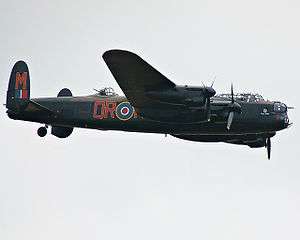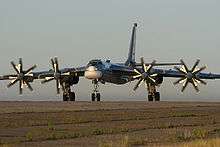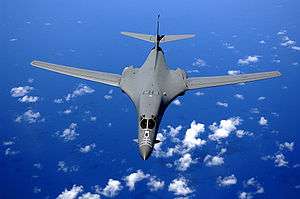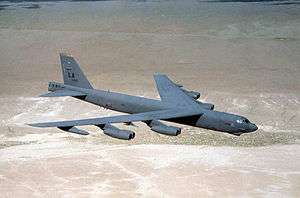Heavy bomber
Heavy bombers are bomber aircraft with the greatest bomb load carrying capacity and longest range of their time. They have also typically been among the largest size aircraft in contemporary military or civil service. Delivery of the largest possible amount of air-to-ground weaponry over long distances to strike enemy targets is the heavy bomber's mission (see also strategic bomber).
The type was first developed in World War I but came to prominence during World War II, when advancements in powerplants and aircraft design enabled four-engined bombers to attack industrial targets in Germany, Italy and Japan. Availability of such large, long range aircraft in mass-produced quantity also allowed methodologies of strategic bombing to be developed and employed during the 1940s. Parallel mid-war developments as well enabled the much smaller typical fighter aircraft to carry an increased 2,000-pound (910 kg) bomb load, and fighter-bombers were taking over from light and medium bombers in the tactical bombing role. In August 1945, the U.S. B-29 heavy bombers delivered two atomic bombs against enemy targets.
The arrival of nuclear weapons permanently changed the nature of warfare and military strategy. After the 1950s intercontinental ballistic missiles and ballistic missile submarines began to supersede heavy bombers in the strategic nuclear role. Along with development of more accurate "smart bombs" and nuclear-armed missiles which could be carried and delivered by smaller fighter-bombers, these technological advancements eclipsed the heavy bomber's once-central role in strategic warfare by the late 20th century. Russian and U.S. heavy bombers have been used in several regional conflicts since World War II (e.g. B-52s in the Vietnam War) delivering conventional weapons only. Heavy bombers are today only retained in service by the U.S., Russia and China for strategic bombing and tactical bombing roles.
World War I
The first heavy bomber was designed as an airliner. Igor Sikorsky, an engineer educated in St Petersburg, but born in Kiev of Polish-Russian ancestry designed the Sikorsky Ilya Muromets to fly between his birthplace and his new home. It did so briefly until August 1914, when the Russo-Balt wagon factory converted to a bomber version, with British Sunbeam Crusader V8 engines in place of the German ones in the passenger plane. By December 1914 a squadron of 10 was bombing German positions on the Eastern Front and by summer 1916 there were twenty. It was well-armed with nine machine guns, including a tail gun and initially was immune to German and Austro-Hungarian air attack.[1] It had a wingspan just a few feet shorter but a bomb load of just 3% of a WW II Avro Lancaster.[2]
The Handley Page Type O/100 owed a lot to Sikorsky's ideas. Of similar size, it used just two Rolls-Royce Eagle engines and could carry up to 2,000 lb (910 kg) of bombs. It was designed at the beginning of the war for the Royal Navy specifically to sink the German High Seas Fleet in Kiel: the Navy called for “a bloody paralyser of an aircraft”[3] Entering service in late 1916 and based near Dunkirk in France, it was used for daylight raids on naval targets, damaging a German destroyer.[4] But after one was lost, it switched to night attacks.
The uprated Handley Page Type O/400 could carry a 1,650 lb (750 kg) bomb, and wings of up to 40 were used by the newly formed, independent Royal Air Force from April 1918 to make strategic raids on German railway and industrial targets.[5] One was used to support T. E. Lawrence's Sinai and Palestine Campaign.
The Imperial German Air Service operated the Gotha bomber, which developed a series of marques. The Gotha G.IV operated from occupied Belgium from the Spring of 1917. It mounted several raids on London beginning in May 1917. Some reached no further than Folkestone or Sheerness on the Kent Coast. But on June 13, Gothas killed 162 civilians, including 18 children in a primary school, and injured 432 in East London. Initially defence against air attack was poor, but by May 19, 1918, when 38 Gothas attacked London, six were shot down and another crashed on landing.[6]
German aircraft companies also built a number of giant bombers, collectively known as the Riesenflugzeug. Most were produced in very small numbers from 1917 onwards and several never entered service. The most numerous were the Zeppelin-Staaken R.VI of which 13 saw service, bombing Russia and London: four were shot down and six lost on landing. They were larger than the standard Luftwaffe bombers of World War II.[7]
The Vickers Vimy, a long-range heavy bomber powered by two Rolls-Royce Eagle engines, was delivered to the newly formed Royal Air Force too late to see action. Only one was in France at the Armistice with Germany. Its intended use was to bomb industrial and railway targets in western Germany, which it could reach with its range of 900 miles (1,400 km) and a bomb load of just over a ton. It is best known as the aircraft that made the first Atlantic crossing from St John's Newfoundland to Clifden in Ireland piloted by the Englishman John Alcock and navigated by Scot Arthur Whitten Brown on June 14, 1919.[8]
Strategic Bomber Theory
Between the wars, aviation opinion fixed on two tenets. The first was that “the bomber will always get through.” The speed advantage of biplane fighters over bombers was insignificant, and it was believed that they would never catch them. Furthermore, there was no effective method of detecting incoming bombers at sufficiently long range to scramble fighters on an interception course. In practice, a combination of new radar technology and advances in monoplane fighter design eroded this disadvantage. Throughout the war, bombers continually managed to strike their targets, but suffered unacceptable losses in the absence of careful planning and escort fighters. Only the later de Havilland Mosquito light bomber was fast enough to evade fighters. Heavy bombers needed defensive armament for protection, which reduced their effective bomb payload.[9]
The second was that strategic bombing of industrial capacity, power generation, oil refineries, and coal mines could win a war. This was certainly vindicated by the firebombing of Japanese cities and the two atomic bombs dropped on Hiroshima and Nagasaki in August 1945, as Japan's fragile housing and cottage industry made themselves easily vulnerable for attack, thus completely destroying Japanese industrial production (See Air Raids on Japan). It was less evident that it held true for the bombing of Germany. During the war, German industrial production actually increased, despite a sustained Allied bombing campaign.[9]
As the German Luftwaffe's main task was to support the army, it never developed a successful heavy bomber. The prime proponent of strategic bombing, General Walther Wever Chief of Staff of the Luftwaffe died in an air crash in 1936 on the very day that the specification for the Ural bomber, later won by the Heinkel He 177, was published. It saw only limited use against the Soviet Union and England. After Wever's death, Ernst Udet, development director at the Air Ministry steered the Luftwaffe towards dive bombers instead.
World War II
When Britain and France declared war on Germany in September 1939, the RAF had no heavy bomber. The Handley Page Halifax and Avro Lancaster both originated as twin engine bombers, but were rapidly redesigned for four Rolls-Royce Merlin engines and rushed into service once the technical problems of the larger Rolls-Royce Vulture emerged. The Halifax joined squadrons in November 1940 and flew its first raid against Le Havre on the night of 11–12 March 1941. British heavy bomber designs often had three gun turrets with a total of 8 machine guns. In January 1941, the Short Stirling reached squadrons. It was based on the successful Short Sunderland flying boat and shared its Bristol Hercules radial engines, wing, cockpit and upper fuselage. The hull of the flying boat was replaced by a lower fuselage. It carried up to 14,000 lb (6,400 kg) of bombs – almost twice as much as a Boeing B-17 Flying Fortress – but over just a 300-mile (480 km) radius. Due to its thick, short wing it was able to out-turn the main German night fighters, the Messerschmitt Bf 110 and the Junkers Ju 88. Heavy bombers still needed defensive armament, for protection, even at night. The Stirling's low operational ceiling of just 12,000 ft (3,700 m) – also caused by the thick wing – meant that it was usually picked on by night fighters; within five months, 67 of the 84 aircraft in service had been lost.
Due to the absence of British heavy bombers, 20 U.S. Army Air Corps (Army Air Forces as of mid-1941) Boeing B-17 Flying Fortresses, were lent to the RAF, which during July 1941, commenced daylight attacks on warships and docks at Wilhelmshaven and Brest. These were complete failures. After eight were lost, due to combat or breakdown and with many engine failures, the RAF stopped daylight bombing by September.[10] It was clear that the B17C model was not combat ready and that its five machine guns gave inadequate protection.
Combat feedback enabled Boeing engineers to improve the aircraft. When the first model B17E started to operate from English airfields in July 1942, it had many more gun turrets including a vital tail gunner. Eventually U.S. heavy bomber designs, optimized for formation flying, had 10 or more machine guns and/or cannons in both powered turrets and manually operated flexible mounts to deliver the best arcs of fire. These guns were located in tail turrets, side gun ports either just behind the bombardier's clear nose glazing as "cheek" positions, or midway along the rear fuselage sides as "waist" positions. U.S. bombers carried .50 caliber machine gun, and dorsal (spine/top of aircraft) and ventral (belly/bottom of aircraft) guns with powered turrets. All of these machine guns could defend against attack when beyond the range of fighter escort. Eventually, 13 machine guns were fitted in the B17G model.[11]
Even this extra firepower, which increased empty weight by 20% and required more powerful versions of the Wright Cyclone engine, was insufficient to prevent serious losses in daylight. Escort fighters were needed but the RAF interceptors such as the Supermarine Spitfire had very limited endurance. An early raid on Rouen-Sotteville rail yards in Brittany on August 17, 1942, required four Spitfire squadrons outbound and five more for the return trip.[12]
The USAAF chose to attack aircraft factories and component plants. On August 17, 1943, 230 Fortresses attacked a ball-bearing plant in Schweinfurt and again two months later, with 291 bombers, in the second raid on Schweinfurt. The works was severely damaged but at huge cost – 36 aircraft in the first raid 77 in the second. Altogether 850 airmen were killed or captured. Only 33 Fortress returned from the October raid undamaged[13]
With the arrival of North American P-51 Mustangs and the fitting of drop tanks to increase the range of the Republic P-47 Thunderbolt for the Big Week offensive, between February 20–25, 1944, bombers were escorted all the way to the target and back. Losses were reduced to 247 out of 3,500 sorties, still devastating but accepted at the time.
The B-24 and later version of the Fortress carried even more extensive defensive armament fitted into Sperry ball turrets. This was a superb defensive weapon that rotated a full 360 degrees horizontally with a 90-degree elevation. Its twin M2 Browning machine guns had an effective range of 1,000 yards (910 m). The Liberator was the result of a proposal to assemble Fortresses in Consolidated plants, with the company returning with its own design of a longer-range, faster and higher-flying aircraft that could carry an extra ton of bombs. Early orders were for France (delivered to the RAF after the fall of France) and Britain, already at war, with just a batch of 36 for the USAAF.[14]
Neither the USAAF nor the RAF judged the initial design suitable for bombing and it was first used on a variety of VIP transport and maritime patrol missions. Its long range, however, persuaded the USAAF to send 177 Liberators from Benghazi in Libya to bomb the Romanian oilfields on August 1, 1943, in Operation Tidal Wave. Due to navigational errors and alerted German flak batteries and fighters, only half returned to base although a few landed safely at RAF bases in Cyprus and some in Turkey, where they were interned. Only 33 were undamaged. Damage to the refineries was soon repaired and oil production actually increased[15]
By October 1942, a new Ford Motor Company plant at Willow Run Michigan was assembling Liberators. Production reached a rate of over one an hour in 1944 helping the B-24 to become the most produced US aircraft of all time. It became the standard heavy bomber in the Pacific and the only one used by the RAAF. The SAAF used Liberators to drop weapons and ammunition during the Warsaw Uprising in 1944.[16]
The Avro Manchester was a twin engine bomber, but it was rapidly redesigned for four Rolls-Royce Merlin engines once the technical problems of the larger Rolls-Royce Vulture emerged. The Manchester used Vulture engines but it was unreliable and under-powered and soon withdrawn. Avro renamed the version with four Merlin engines and longer wings the Avro Lancaster. It reached squadrons early in 1942. It could carry 14,000 lb (6,400 kg) of bombs or with special modifications 22,000 lb (10,000 kg). More importantly, the bomb bay was undivided, so that it could carry monster bombs such as the 10-ton Grand Slam bomb.[17]
Barnes Wallis deputy chief aircraft designer at Vickers spent much time thinking about weapons that might shorten the war. He conceived his “Spherical Bomb, Surface Torpedo” after watching his daughter flip pebbles over water. Two versions were developed: the smaller Highball was to be used against ships and attracted essential British Admiralty funding for his project. A 1,280 lb (580 kg) flying torpedo, of which half was Torpex torpedo explosive, it was developed specifically to sink the Tirpitz which was moored in Trondheim fjord behind torpedo nets. However development delays meant that another Barnes Wallis invention, the 5 ton Tallboy was used instead. Two dropped by Avro Lancasters from 25,000 ft (7,600 m) hit at supersonic speed and capsized the Tirpitz on November 12, 1944. Upkeep, the larger version, was used to destroy the Mohne and Eder dams by Lancasters from the specially recruited and trained 617 Squadron, often known as the Dambusters, under Wing Commander Guy Gibson.[18]
In March and April 1945, as the war in Europe was ending, Lancasters dropped Grand Slams and Tallboys on U-boat pens and railway viaducts across north Germany. At Bielefeld more than 100 yards (91 m) of railway viaduct was destroyed by Grand Slams creating an earthquake effect, which shook the foundations.[19]
The Boeing B-29 Superfortress was a development of the Fortress, but a larger design with four Wright R-3350 Duplex-Cyclone engines of much greater power, enabling it to fly higher, faster, further and with a bigger bomb load. The mammoth new radial engines were subject to overheating if anything malfunctioned, however and technical problems with the powerplant seriously delayed the B-29's debut. The aircraft had four remotely operated twin-gun turrets on its fuselage, controlled through an analog computer sighting system; the operator could use any of a trio of Perspex ball stations. Only the rear tail gunner had to control his gun manually.[20]
B-29s were deployed initially to bases in India and China, from which they could reach Japan; but the logistics of flying from these remote, primitive airfields were complicated and costly. The island of Saipan in the Marianas was assaulted to provide Pacific air bases, from which to bomb Japanese cities. Initial high-level, high-explosive daylight bombing raids on Japanese cities with their wood and paper houses were disappointing. So the bombers were switched to low-level, nighttime incendiary attacks, for which they had not originally been designed (one variant, the B-29B was specially modified for low altitude night missions by removal of armament and other equipment). Japan burned furiously. On August 6, 1945, B-29 Enola Gay dropped an atomic bomb on Hiroshima. Three days later, B-29 Bockscar dropped another on Nagasaki. The war was over.[21]
After World War II
After World War II, the name strategic bomber came into use, for aircraft that could carry aircraft ordnances over long distances behind enemy lines. They were supplemented by smaller fighter-bombers with less range and lighter bomb load, for tactical strikes. Later these were called strike fighters, attack aircraft and multirole combat aircraft.
When North Korea attacked South Korea in 1950 the USAF responded with daylight bomber raids on supply lines through North Korea. B-29 Superfortresses flew from Japan on behalf of the United Nations. But the supply to North Korea's army from the Soviet Union was physically and politically out of reach. There were no worthwhile strategic targets in North Korea. The Soviet mentored Northern forces easily routed the South Korean army.[22] The distance to North Korea was too great for fighter escorts based in Japan. So the B-29s flew alone. In November, Mikoyan-Gurevich MiG-15s flown by Soviet pilots started to intercept the US bombers, over North Korea. The MiG-15 was specifically designed to master US heavy bombers, with nuclear weapons. It could out-perform any fighter deployed by United Nations air forces in Korea. After 28 B-29s were lost, it was restricted to night interdiction and concentrated on destroying supply routes, including the bridges over the Yalu river into China.[23]
By the 1960s, manned heavy bombers could not match the intercontinental ballistic missile in the strategic nuclear role. More accurate precision-guided munitions ("smart bombs"), nuclear-armed missiles or bombs were able to be carried by smaller aircraft such as fighter-bombers and multirole fighters. Despite these technological innovations and new capabilities of other contemporary military aircraft, large strategic bombers such as the B-1, B-52 and B-2 have been retained for the role of carpet bombing in several conflicts. The most prolific example (in terms of total bomb tonnage) is the U.S. Air Force B-52 Stratofortress during the 1960s–early 1970s Vietnam War era, in Operation Menu, Operation Freedom Deal, and Operation Linebacker II. In 1987, Soviet Tu-160, the heaviest supersonic bomber/aircraft ever built, entered service; it can carry twelve long-range cruise missiles.
The 2010 New START agreement between the United States of America and the Russian Federation defined a "heavy bomber" by two characteristics:
- range greater than 8,000 kilometres (5,000 mi)
- equipped for long-range nuclear "air-launched cruise missiles" (ALCMs), defined as an air-to-surface cruise missile of a type flight-tested from an aircraft or deployed on a bomber after 1986.
Notable heavy bombers
World War I
-
.svg.png) Caproni Ca.4
Caproni Ca.4 -
.svg.png) Caproni Ca.5
Caproni Ca.5 -
 Handley Page Type O
Handley Page Type O -
 Handley Page V/1500
Handley Page V/1500 -
 Gotha G.IV
Gotha G.IV -
 Gotha G.V
Gotha G.V -
 Sikorsky Ilya Muromets
Sikorsky Ilya Muromets -
 Vickers Vimy
Vickers Vimy -
 Zeppelin-Staaken R.VI
Zeppelin-Staaken R.VI
Interwar period (interbellum)
-
.svg.png) Caproni Ca.90
Caproni Ca.90 -
 Farman F.220
Farman F.220 -
 Fairey Hendon
Fairey Hendon -
 Handley Page Heyford
Handley Page Heyford -
 Handley Page Hinaidi
Handley Page Hinaidi -
 B-2 Condor
B-2 Condor -
.svg.png) Junkers Ju 89
Junkers Ju 89 -
 Mitsubishi Ki-20
Mitsubishi Ki-20 -
 Tupolev TB-3
Tupolev TB-3 -
 Petlyakov Pe-8
Petlyakov Pe-8
World War II
-
 Avro Lancaster
Avro Lancaster -
 Bloch MB.162
Bloch MB.162 -
 B-17 Flying Fortress
B-17 Flying Fortress -
 B-24 Liberator
B-24 Liberator -
 B-29 Superfortress
B-29 Superfortress -
 Consolidated B-32 Dominator
Consolidated B-32 Dominator -
.svg.png) Dornier Do 19
Dornier Do 19 -
.svg.png) Dornier Do 317
Dornier Do 317 -
 Handley Page Halifax
Handley Page Halifax -
.svg.png) Heinkel He 177
Heinkel He 177 -
.svg.png) Heinkel He 274
Heinkel He 274 -
 Mitsubishi Ki-67
Mitsubishi Ki-67 -
 Nakajima G8N
Nakajima G8N -
 Petlyakov Pe-8
Petlyakov Pe-8 -
.svg.png) Piaggio P.108
Piaggio P.108 -
 Short Stirling
Short Stirling -
 XB-15
XB-15 -
 XB-19
XB-19
Cold War
-
 Avro Lincoln
Avro Lincoln -
 Avro Vulcan
Avro Vulcan -
 Handley Page Victor
Handley Page Victor -
 Vickers Valiant
Vickers Valiant -
 B-1 Lancer
B-1 Lancer -
 B-36 Peacemaker
B-36 Peacemaker -
 B-58 Hustler
B-58 Hustler -
 B-47 Stratojet
B-47 Stratojet -
 B-50 Superfortress
B-50 Superfortress -
 B-52 Stratofortress
B-52 Stratofortress -
 Myasishchev M-4
Myasishchev M-4 -
 Tupolev Tu-4
Tupolev Tu-4 -
 Tupolev Tu-16
Tupolev Tu-16 -
 Tupolev Tu-95
Tupolev Tu-95 -
 Tupolev Tu-160
Tupolev Tu-160
Post-Cold War
21st Century
-
 Northrop Grumman B-21
Northrop Grumman B-21 -
 PAK DA (Early reports suggests of a radius of 3,500 km (2,200 mi) with full payload and a range of 12,000 km (7,500 mi) with standard payload. Specifications may change in future.)
PAK DA (Early reports suggests of a radius of 3,500 km (2,200 mi) with full payload and a range of 12,000 km (7,500 mi) with standard payload. Specifications may change in future.)
See also
- 2037 Bomber
- Next-Generation Bomber
- Long Range Strike Bomber
- Northrop Grumman B-21 Raider
- Tupolev PAK DA
- Xian H-20
Notes
- ↑ Winchester, Jim. "Sikorsky Ilya Muromets." Biplanes, Triplanes and Seaplanes (Aviation Factfile). London: Grange Books 2004. ISBN 1-84013-641-3
- ↑ David, Donald ed. The complete encyclopaedia of world aircraft. Noble and Barnes, New York 1977. ISBN 0-7607-0592-5
- ↑ Thetford, Owen, British Naval Aircraft Since 1912: 1991 Naval Institute Press, Annapolis, MD ISBN 1-55750-076-2
- ↑ Bowyer, Chaz. Handley Page Bombers: 1992 Aston Publications Bourne End, Bucks, England: ISBN 0-946627-68-1
- ↑ Bruce, J. M. Handley Page 0/100 and 0/400: Historic Military Aircraft No.4. Flight ;27 February 1953,Vol. LXIII. issue No. 2301
- ↑ Cole, Christopher and E.F. Cheesman. The Air Defence of Great Britain 1914–1918. London: Putnam, 1984. ISBN 0-370-30538-8
- ↑ G.W. Haddow & Peter M. Grosz The German Giants, The Story of the R-planes 1914–1919, Putnam & Company Limited, London 1962
- ↑ Andrews, C.F. and Eric B. Morgan. Vickers Aircraft since 1908, Second edition. London: Putnam, 1988. ISBN 0-85177-815-1
- 1 2 Tate, Dr. James P. The Army and its Air Corps: Army Policy toward Aviation 1919–1941.] Maxwell Air Force Base, Alabama: Air University Press, 1998. ISBN 1-4289-1257-6.
- ↑ Chant, Christopher. Warplanes of the 20th century. London: Tiger Books International, 1996. ISBN 1-85501-807-1
- ↑ Bowers, Peter M. Fortress In The Sky, Granada Hills, California: Sentry Books, 1976. ISBN 0-913194-04-2.
- ↑ Bowers, Peter M. Fortress In The Sky, Granada Hills, California: Sentry Books, 1976. ISBN 0-913194-04-2
- ↑ Craven. Wesley, James Cate The Army Air Forces in World War II, Volume Two: Europe, Torch to Pointblank, August 1942 to December 1943 Chicago: University of Chicago 1954 ISBN 0-912799-03-X
- ↑ Birdsall, Steve. The B-24 Liberator. New York: Arco Publishing Company, Inc., 1968. ISBN 0-668-01695-7.
- ↑ Dugan, James and Carrol Stewart: The Ploesti Raid: the great air-ground battle of August 1, 1943, Brassey's, Washington DC. 1998 ISBN 1-57488-510-3
- ↑ cite Davies, Norman; Rising '44: The Battle for Warsaw. 2004 Pan Macmillan London ISBN 978-0-330-48863-1
- ↑ Jacobs, Peter. The Lancaster Story. London: Arms & Armour Press, 1996. ISBN 1-85409-456-4
- ↑ Holland, James:.Dam Busters Bantam Press, 2012 ISBN 978-0-552-16341-5
- ↑ Flower, Stephen. "Barnes Wallis’ Bombs." 2004; Tempus , Strood. ISBN 0-7524-2987-6
- ↑ Willis, David. "Boeing B-29 and B-50 Superfortress". International Air Power Review, Volume 22, 2007, Westport, Connecticut: AIRtime ISBN 1-880588-79-X
- ↑ Willis, David. "Boeing B-29 and B-50 Superfortress". International Air Power Review, Volume 22, 2007, Connecticut: AIRtime ISBN 1-880588-79-X
- ↑ Malkasian, Carter, The Korean War 1950-53. Essential Histories. Fitzroy Dearborn London, Chicago 2001. ISBN 1-57958-364-4
- ↑ Yefim, Gordon, The Mikoyan-Gurevich MiG-15, Midland Publishing, Leicester, UK 2005 ISBN 1-85780-105-9
References
- Ambrose, Stephen E. The Wild Blue: The Men and Boys Who Flew the B-24s over Germany. New York: Simon & Schuster, 2001. p. 299
- Johnsen, Frederick A. "Ball Turret: Shattering the Myths." Air Power History 1996 43(2): p. 14-21. ISSN 1044-016X
- Johnson, Robert E. "Why the Boeing B-29 Bomber, and Why the Wright R-3350 Engine?" American Aviation Historical Society Journal 1988 33(3): p. 174-189. ISSN 0002-7553
- VanderMeulen, Jacob. Building the B-29. Smithsonian Inst. Press, 1995. p. 104






